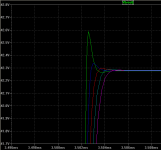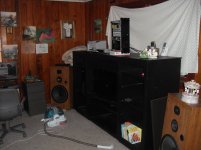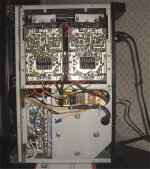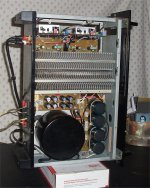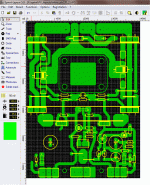I was messing with square waves this morning and had left in a .step comand with stepped values of the front end degeneration resistors. The .step starts at 20 and goes to 100. Note the effect on speed and overshoot. Also note the lack of ringing. Just thought it was interesting enough to share.
Ken
Ken
Attachments
I was messing with square waves this morning and had left in a .step comand with stepped values of the front end degeneration resistors. The .step starts at 20 and goes to 100. Note the effect on speed and overshoot. Also note the lack of ringing. Just thought it was interesting enough to share.
Ken
Front end degen. resistor changes will lower or raise the unity gain point of the amp , therefore also affecting phase margin. Similar .step results would also be seen from .step CDOM 20 100 20 ,where the main miller cap was replaced by {CDOM} . This is useful when you just have a 47pF cap , for instance .. but have designed for a 68pF. Then you just increase LTP emitter degen. to compensate , resulting in the exact same UG/phase margin.
A direct result of lowering/raising UG is varying degrees of overshoot on the leading edge of a square wave.
OS
Consider that many sources contain "sluggish" op-amps (LF353 = 9-10V/uS) or NE5532. From performance to speaker [in the recording], there are at least one of these devices in the chain. Of course , one could create the source. My VST synthesizer will create a sawtooth waveform with 50+ V/us rise time right out of the sound card.
Soooo , even if your sound card has SMD OPA devices (500v/us) , the slew would be only as fast as the weakest link (source/or devices). To go overboard with 200V/uS might increase the likelihood of a tweeter failure.
OS
Tweeter protection--its the speaker designer's choice. And, it might not be expensive.
For example:
In Addition to a 2nd order crossover and fixed/real l-pad that you might expect. . .
Adding 10uF Nichicon ES // 100nF Polyester, right at the tweeter, in series at whichever tweeter terminal connects to the least amount of crossover components may provide significant tweeter projection for the bargain price of 35 cents.
I might just need some "protection". I can't wait !!!!! The heck with the blue wire and euroconnectors (I can put them in afterwards).Tweeter protection--its the speaker designer's choice. And, it might not be expensive.
For example:
In Addition to a 2nd order crossover and fixed/real l-pad that you might expect. . .
Adding 10uF Nichicon ES // 100nF Polyester, right at the tweeter, in series at whichever tweeter terminal connects to the least amount of crossover components may provide significant tweeter projection for the bargain price of 35 cents.
TOMORROW I will fire the Nikko up and audition it. I have run both amps for 48 hour "torture tests" , so I know there will be no flaws.


All I have to do is hook up the 2 PS's,wire the AC/fuse/power switch and "juryrig" the relay up to be switchable from the front panel. Everything has been pre-tested.
OS
I'm not suggesting you make one of these - but a load of non wire wound carbon resistors will result in less induction than the WW.
For slew testing purposes, I think you want a very inert load. An array of carbon resistors (which are cheap anyway) mounted between 2 PCBs and submerged in oil I think might work well enough. I've read about resistor arrays submerged in oil used as antenna dummy loads.
Another option is to use a normal wirewound, measure it's inductance, and create a Zobel constant-impedance network. A carbon comp resistor could be used for the second resistor, which would only experience high frequencies, and may not need as high a power rating as long as the input frequency stayed in the audio range.
https://secure.wikimedia.org/wikipedia/en/wiki/Zobel_network#Zobel_networks_and_loudspeaker_drivers
Look I have years hearing "live music" (I am a sax player aficionado) I can discern when the tip of the stick hitting an AVEDIS ZYLDJIAN cymbal is metallic, plastic or wood, same for a clavichord, given a good recording this subtle sounds are partially masked or are difficult to hear when the amp is short of trebles, I know that the sound isn't as it should be, not good for me ... "Musicality" is a cultural and subjective sensation related to pleasure, brain loves some bias specially the 2nd harmonic, is like adding sugar to wine, for a bad wine maybe OK but certainly you would not like to add sugar to a fine good French or Chilean wine.
Can you name specific recordings?
For slew testing purposes, I think you want a very inert load. An array of carbon resistors (which are cheap anyway) mounted between 2 PCBs and submerged in oil I think might work well enough. I've read about resistor arrays submerged in oil used as antenna dummy loads.
Another option is to use a normal wirewound, measure it's inductance, and create a Zobel constant-impedance network. A carbon comp resistor could be used for the second resistor, which would only experience high frequencies, and may not need as high a power rating as long as the input frequency stayed in the audio range.
https://secure.wikimedia.org/wikipedia/en/wiki/Zobel_network#Zobel_networks_and_loudspeaker_drivers
QUOTE]
Keantoken,
Got me thinking, would be a simple thing to do, this Zobel load rig. But then you have to ask, isn't the amp being designed the to drive these mixed loads of inductance and resistance - eg speakers? What's the point in a theoretical slew if the real load slew is different? Seems like these wire wound resistors are a fair representation of a speaker - note the word "fair", not "perfect" or "accurate". Just a thought...
Ken
Keantoken,
Got me thinking, would be a simple thing to do, this Zobel load rig. But then you have to ask, isn't the amp being designed the to drive these mixed loads of inductance and resistance - eg speakers? What's the point in a theoretical slew if the real load slew is different? Seems like these wire wound resistors are a fair representation of a speaker - note the word "fair", not "perfect" or "accurate". Just a thought...
Ken
True, but there really is no telling what the amp will be hooked up to. What about electrostatics? Crossovers?
I think what we need is a big heavy box with a patch board and three heavy-duty switches so we can construct any high-power load we want to emulate.
I think if we wanted to, it wouldn't be hard to test the amp with any reactive configuration. I don't think there is a single load that will satisfy all demands. It would be easier to construct as needed, if such thorough testing is called for.
- keantoken
What would be the meaning of taking a slew rate test into a speaker? A speaker probably would hardly load the amp at all at those frequencies. It wouldn't be much different from measuring slew rate with no load at all. What are we measuring slew rate for anyways, besides to know the amp works as simulated?
PS I spy Jim Leach in the viewers...
- keantoken
PS I spy Jim Leach in the viewers...
- keantoken
True, but there really is no telling what the amp will be hooked up to. What about electrostatics? Crossovers?
I think what we need is a big heavy box with a patch board and three heavy-duty switches so we can construct any high-power load we want to emulate.
I think if we wanted to, it wouldn't be hard to test the amp with any reactive configuration. I don't think there is a single load that will satisfy all demands. It would be easier to construct as needed, if such thorough testing is called for.
- keantoken
I built a rig as you described. I used speaker banana jack terminals to connect it to the amp and load along with a switch to switch in/out capacitors and a double pole double throw switch to put either 1uf or .47uf into the circuit. My loads are not switched, rather the wires are also terminated with banana jacks, so, i just plug in the load I want as well. It makes it quite fast to test a variety of load configurations. If interested I could post a picture tonight.
Ken
Oh , you are alive... KT.What would be the meaning of taking a slew rate test into a speaker? A speaker probably would hardly load the amp at all at those frequencies. It wouldn't be much different from measuring slew rate with no load at all. What are we measuring slew rate for anyways, besides to know the amp works as simulated?
PS I spy Jim Leach in the viewers...
- keantoken
To elaborate , the slew test was just what you said , a mental exercise to compare to LT's output. It made a dandy "burn -in" for the amps, as well.
As we well know , 100v+/uS put to a speaker is meaningless with inductance and other real world factors in play. But , the fact that the amp CAN reproduce that fast a transient means that everyday sources will be quite easy for it. Normal use is nothing like those square waves (at least heat wise), running a 40v p-p sine produced nowhere as much heat. Both channels driven overnight with the 60v p-p SW created quite a hot little unit.



Tonight I wire it/listen to it. (doing that now!)
OS
I might just need some "protection". I can't wait !!!!! The heck with the blue wire and euroconnectors (I can put them in afterwards).
TOMORROW I will fire the Nikko up and audition it. I have run both amps for 48 hour "torture tests" , so I know there will be no flaws.
All I have to do is hook up the 2 PS's,wire the AC/fuse/power switch and "juryrig" the relay up to be switchable from the front panel. Everything has been pre-tested.
OS
The nearest auto parts store has that wire in many colors.
The dodgy, miniature, screw down blocks as shown DO fail in the field--shipping shakes them loose. Perhaps you could use something safer, such as spade (same connector type as a 25a square unit rectifier). Its nice to both crimp And solder the spades onto the wire. And, spades are available at same store as the wire.
So, off you go to the auto parts store.
EDIT: A large, heavy-duty connector, with its own, inbuilt, non-stop, strong force is usually safer (or more resilient to movement) than miniature screw terminals. Personally, I've had too many accidents with screw terminals.
P.S. I've a speaker project stalled right now over getting some 2 conductor wire that's got black-white or red-black or red-white, to avoid mix-up when soldering a unique crossover.
Last edited:
You realize, of course, that you will be unable to judge the sonics of the equipment, as you have too much emotionally invested....
Now I duck and run for cover.
Just kidding... I hope it sounds great! Please report back on the results.
No need to do that.
I've built so many amps now that this is just " another one ? " or " at it again ? " ... as my wife puts it.....
Subjectiveness sucks... I suppose I will just play my favorite music on it and the hell with comparisons ( although I might "cave in"
OS
dodgy ??
Maybe the chinese or cheap ones do, but the mouser "Madow" or" Molex" ones I use are industrial duty. I have gel cell chargers out in the field (solar) that are 15 years old with those connectors and they look the same as when they were built. Maybe you've seen bad ones on Ebay chip amp kits or something ... but ALL the mouser ones are "bulletproof". The screws do not fall out of the molex ones even when loose (without a wire in them) The madow one's do , but not if a wire has been screwed down ... the madow's will make the best high current connection and can do 15A per position, so I use molex for signal and madow for current.
OS
The dodgy, miniature, screw down blocks as shown DO fail in the field
Maybe the chinese or cheap ones do, but the mouser "Madow" or" Molex" ones I use are industrial duty. I have gel cell chargers out in the field (solar) that are 15 years old with those connectors and they look the same as when they were built. Maybe you've seen bad ones on Ebay chip amp kits or something ... but ALL the mouser ones are "bulletproof". The screws do not fall out of the molex ones even when loose (without a wire in them) The madow one's do , but not if a wire has been screwed down ... the madow's will make the best high current connection and can do 15A per position, so I use molex for signal and madow for current.
OS
I'm listening !!
( below 1)... means "you know watt" (REAL NICE "firstwatt" )
(REAL NICE "firstwatt" )
Jumping up to the 68-60-0-60-68V supplies made my offset go to 5mV
(Boo-Hoo ) . The wiring (below 2 ) is a "cobjob" by my standards , need a mouser order. Looks nice on top (below 3).
) . The wiring (below 2 ) is a "cobjob" by my standards , need a mouser order. Looks nice on top (below 3).
Listening , NO thump , dead silent (even with 330R/headphones). Boston,Floyd and SAGA FLAC's are being used for critical listening. high end detail is flawless , bass is better than the last AX. Vocals are "right in your face". Sonically , it is about what I expected (totally transparent).
I'll let my daughter listen to her " Classical Thunder" tomorrow. Too late to go "nuclear".
OS
( below 1)... means "you know watt"
Jumping up to the 68-60-0-60-68V supplies made my offset go to 5mV
(Boo-Hoo
Listening , NO thump , dead silent (even with 330R/headphones). Boston,Floyd and SAGA FLAC's are being used for critical listening. high end detail is flawless , bass is better than the last AX. Vocals are "right in your face". Sonically , it is about what I expected (totally transparent).
I'll let my daughter listen to her " Classical Thunder" tomorrow. Too late to go "nuclear".
OS
Attachments
The bass is better? What part/portion of the amp is the cause of the improvement?
P.S.
Regarding the screw terminals, well there's another "strict quality control" item; but, personally I'd omit the screw terminals and specify solder connections instead, pretty much because the 18ga solid wire isn't difficult.
P.P.S.
Speaker jacks. . . Although I really like 1/4" jacks, these 66 cents super-sized spring clips have a proportionately larger clamping force (fierce nonstop pressure): Two Conductor Speaker Terminal The 1/4" jacks and huge 12ga clips are examples of "Daniel-proof" connectors.
P.S.
Regarding the screw terminals, well there's another "strict quality control" item; but, personally I'd omit the screw terminals and specify solder connections instead, pretty much because the 18ga solid wire isn't difficult.
P.P.S.
Speaker jacks. . . Although I really like 1/4" jacks, these 66 cents super-sized spring clips have a proportionately larger clamping force (fierce nonstop pressure): Two Conductor Speaker Terminal The 1/4" jacks and huge 12ga clips are examples of "Daniel-proof" connectors.
Last edited:
The bass is better? What part/portion of the amp is the cause of the improvement?
Now at moderate volume ... everything is better. Best Mongrel of all.
ONE FATAL FLAW
Amp will thermally stabilize , but with the front OP's biased twice the rears
The boards are almost redesigned (below 1) same circuit (IT'S PERFECT) ,just an anal "thermal issue". Another chapter in R/D.
Even as a "fucup", this is a awesome sounding amp.
OS
Attachments
Last edited:
Many thanks to the experts !
No one advised me about my oblivious oversight. So many experts , no opinions.
In the end , by the "school of hard knocks" , I will blow by them like a jet airplane. So , again ... thanks for all the good advise (or the default silence , leaving me to my own devices).
OS
No one advised me about my oblivious oversight. So many experts , no opinions.
In the end , by the "school of hard knocks" , I will blow by them like a jet airplane. So , again ... thanks for all the good advise (or the default silence , leaving me to my own devices).
OS
ONE FATAL FLAW
having the drivers on just one of the heatsinks makes the front heatsink bias harder than the back one (the one without the drivers).
OS
So how much was the temperature differential between the 2 sinks due to the drivers and how different was the Vbe between the front and rear sink outputs ?
- Status
- This old topic is closed. If you want to reopen this topic, contact a moderator using the "Report Post" button.
- Home
- Amplifiers
- Solid State
- The MONGREL (supersym II)
